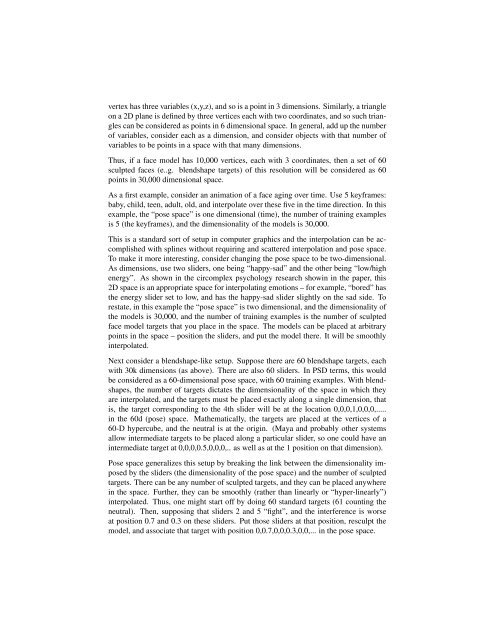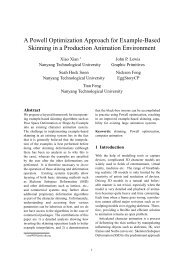Pose Space Deformation Notes - JP Lewis
Pose Space Deformation Notes - JP Lewis
Pose Space Deformation Notes - JP Lewis
Create successful ePaper yourself
Turn your PDF publications into a flip-book with our unique Google optimized e-Paper software.
vertex has three variables (x,y,z), and so is a point in 3 dimensions. Similarly, a triangle<br />
on a 2D plane is defined by three vertices each with two coordinates, and so such triangles<br />
can be considered as points in 6 dimensional space. In general, add up the number<br />
of variables, consider each as a dimension, and consider objects with that number of<br />
variables to be points in a space with that many dimensions.<br />
Thus, if a face model has 10,000 vertices, each with 3 coordinates, then a set of 60<br />
sculpted faces (e..g. blendshape targets) of this resolution will be considered as 60<br />
points in 30,000 dimensional space.<br />
As a first example, consider an animation of a face aging over time. Use 5 keyframes:<br />
baby, child, teen, adult, old, and interpolate over these five in the time direction. In this<br />
example, the “pose space” is one dimensional (time), the number of training examples<br />
is 5 (the keyframes), and the dimensionality of the models is 30,000.<br />
This is a standard sort of setup in computer graphics and the interpolation can be accomplished<br />
with splines without requiring and scattered interpolation and pose space.<br />
To make it more interesting, consider changing the pose space to be two-dimensional.<br />
As dimensions, use two sliders, one being “happy-sad” and the other being “low/high<br />
energy”. As shown in the circomplex psychology research showin in the paper, this<br />
2D space is an appropriate space for interpolating emotions – for example, “bored” has<br />
the energy slider set to low, and has the happy-sad slider slightly on the sad side. To<br />
restate, in this example the “pose space” is two dimensional, and the dimensionality of<br />
the models is 30,000, and the number of training examples is the number of sculpted<br />
face model targets that you place in the space. The models can be placed at arbitrary<br />
points in the space – position the sliders, and put the model there. It will be smoothly<br />
interpolated.<br />
Next consider a blendshape-like setup. Suppose there are 60 blendshape targets, each<br />
with 30k dimensions (as above). There are also 60 sliders. In PSD terms, this would<br />
be considered as a 60-dimensional pose space, with 60 training examples. With blendshapes,<br />
the number of targets dictates the dimensionality of the space in which they<br />
are interpolated, and the targets must be placed exactly along a single dimension, that<br />
is, the target corresponding to the 4th slider will be at the location 0,0,0,1,0,0,0,.....<br />
in the 60d (pose) space. Mathematically, the targets are placed at the vertices of a<br />
60-D hypercube, and the neutral is at the origin. (Maya and probably other systems<br />
allow intermediate targets to be placed along a particular slider, so one could have an<br />
intermediate target at 0,0,0,0.5,0,0,0,.. as well as at the 1 position on that dimension).<br />
<strong>Pose</strong> space generalizes this setup by breaking the link between the dimensionality imposed<br />
by the sliders (the dimensionality of the pose space) and the number of sculpted<br />
targets. There can be any number of sculpted targets, and they can be placed anywhere<br />
in the space. Further, they can be smoothly (rather than linearly or “hyper-linearly”)<br />
interpolated. Thus, one might start off by doing 60 standard targets (61 counting the<br />
neutral). Then, supposing that sliders 2 and 5 “fight”, and the interference is worse<br />
at position 0.7 and 0.3 on these sliders. Put those sliders at that position, resculpt the<br />
model, and associate that target with position 0,0.7,0,0,0.3,0,0,... in the pose space.







